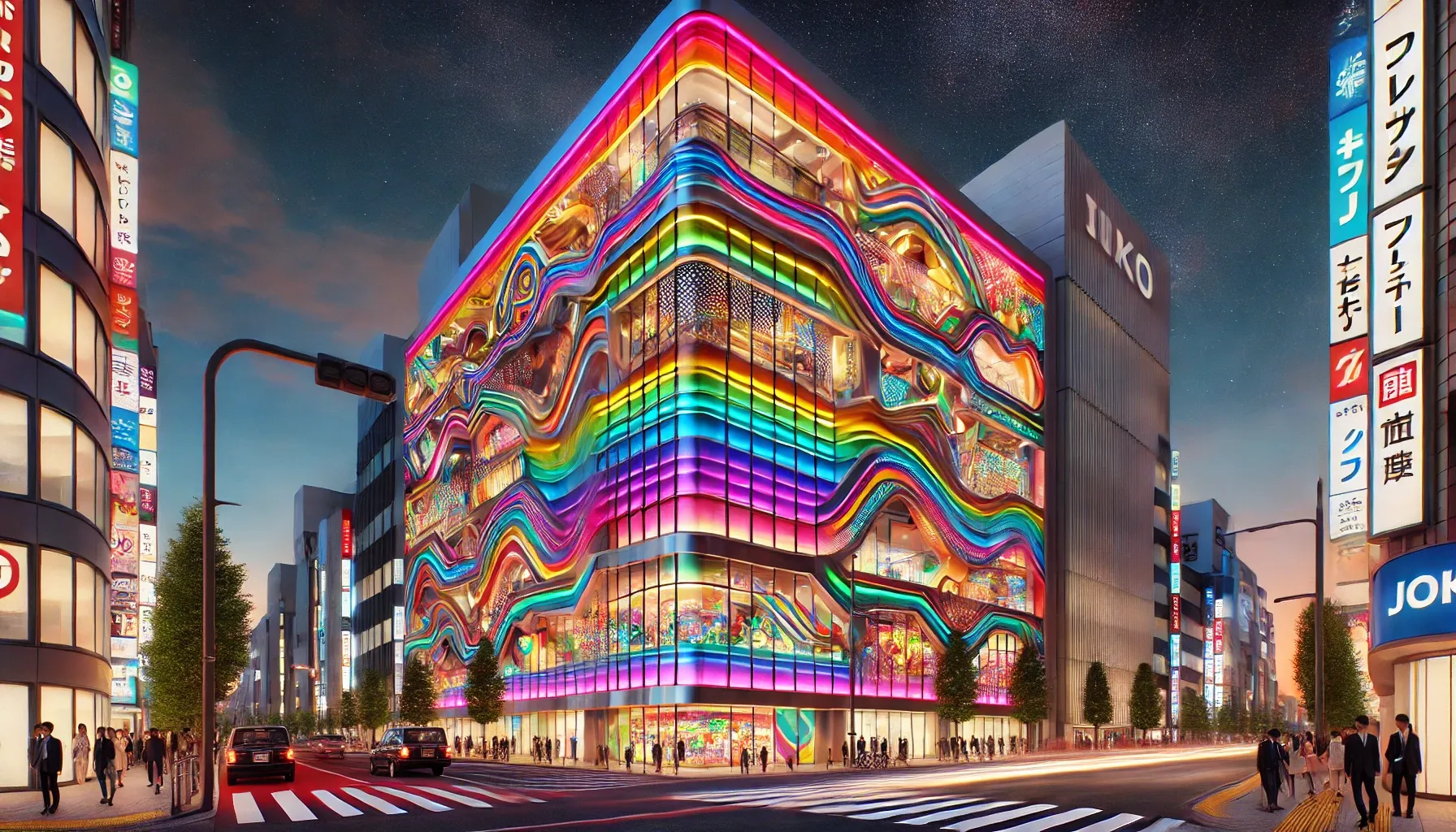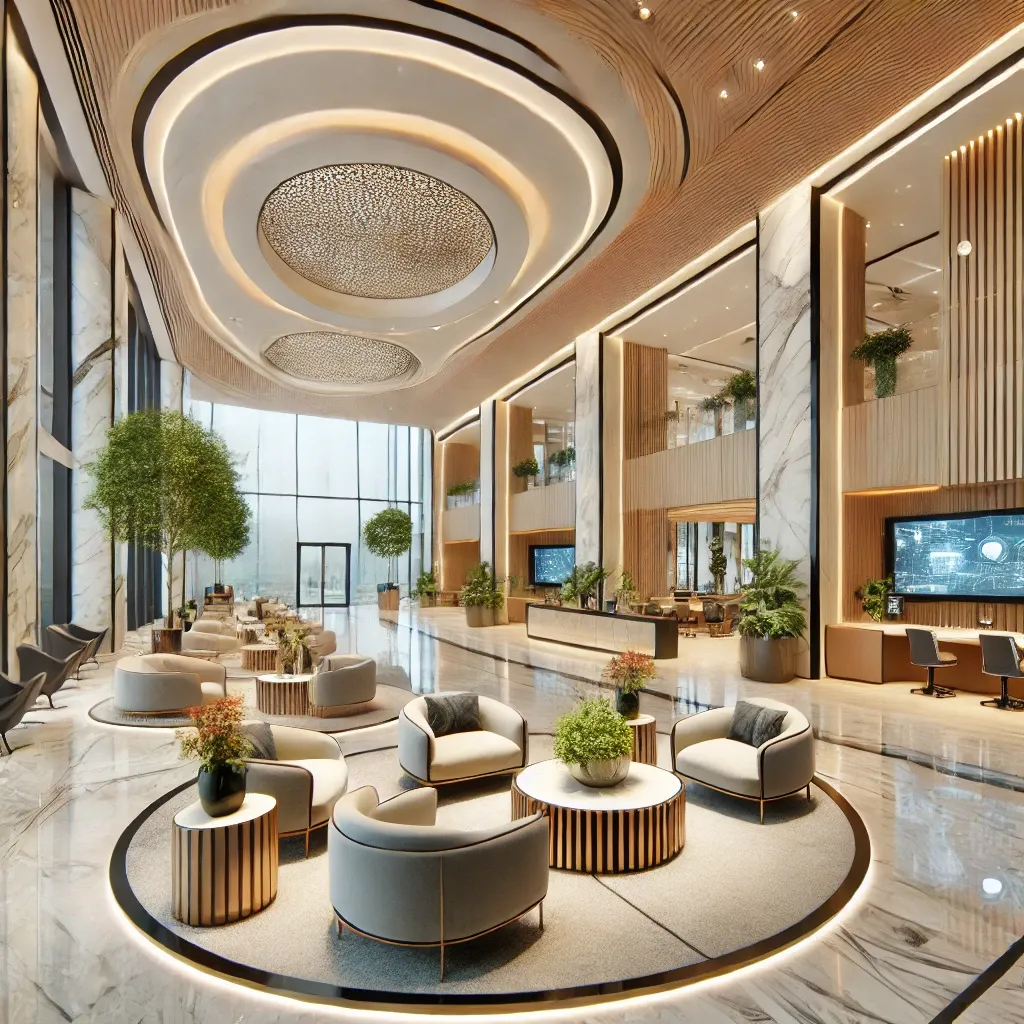Architectural masterpieces of banks: how design influences customer experience?

- Unique architectural solutions of banks around the world
- How are modern banks rethinking the design of their offices?
Sugamo Shinkin Bank in Tokyo
The Sugamo Shinkin Bank, located in Tokyo, attracts attention not only for its customer-oriented service but also for its striking modern design. It was designed by French architect Emmanuel Muro, who employed an interesting method for the facade design.
Each of the twelve bright horizontal stripes, varying in width, creates a striking visual array, especially when the building is illuminated by night lights, transforming it into a unique spectacle. The architect described this building as"rainbow layered cake"that best conveys its unique style and atmosphere.
Moroccan Bank of Foreign Trade (BMCE)
Another interestingly designed bank is the Moroccan Bank of Foreign Trade (BMCE). This project became a landmark for the architectural firm Foster & Partners, as it is their first project on the African continent.
This building pays special attention to the wide windows, which are protected by elegant stainless steel grilles with minimal iron content. This architectural detail not only attracts attention but also plays an important role in ensuring comfortable conditions in a hot climate by providing good ventilation and allowing sunlight to pass through.
For the design, the following were usedblack graniteandgray limestone, extracted in close proximity to the building.
Frost Bank in Austin
Frost Bank, located in Austin, Texas, stands out among other local buildings due to its unique shape. The top of this skyscraper, resembling a pyramid with a crown, creates a distinctive silhouette.
The building's facade is framed with modern next-generation glass —low-ethat allows light to pass through while preventing ultraviolet and infrared rays from entering, significantly reducing heat loss.
It's interesting that in Austin, only the Reuters office in New York can boast similar low-e blue glass, which highlights the uniqueness of this project.
Vital Bank in Spain
The architects of the Vital bank in Spain aimed to create a structure that resembles a living organism. The main facade is designed in a style of black glass, almost invisible against the bright decorative coating of stainless steel, which represents massive chromosomes.
This creative approach highlightsmodernityandindividualityobject.
The new Nordea bank office in Copenhagen
By 2016, the construction of a new Nordea bank office will be completed in Copenhagen, which promises to become an architectural landmark of the Danish capital. The complex will cover an area of about40 thousand square metersand accommodate approximatelytwo thousand employees.
The project conceptually represents“mini-city”where separate quiet areas for work are provided, as well as large open spaces and "streets" for communication and interaction among employees.
It is expected that this project will receiveplatinum LEED certificationconfirming its high standards of sustainable construction.
BNP Paribas bank office in Paris
In the capital of France, Paris, there is an office of BNP Paribas bank, which stands out among typical financial institutions.
29 January
9 October 2024
9 October 2024
29 September


When designing the interiors, furniture pieces from well-known designers were used, such as:
- Christophe Delcourt
- India Mahdavi
- Pierre Polin
- Philippe Starck
- Karim Rashid
Saxo Bank in Copenhagen
Saxo Bank, which opened in Copenhagen in 1992, has achieved impressive results in the international financial sector in a relatively short time, becoming a significant player in the field of online investments.
The architectural design of the Saxo headquarters was created by the renowned studio 3XN: the diagonal lines on the building's facade symbolize a combination of stability and movement.
The bank's interior spaces are designed with a focus on comfort and convenience:
- a variety of areas for relaxation and dining
- a bright hall with a stained glass ceiling
- a stunning spiral staircase leading to the upper floors
PKO Bank Polski in Warsaw
PKO Bank Polski, located in Warsaw, was designed by Robert Majkut, who used the institution's brand colors:black, white, and gold.
The concept of interior design combines aesthetic elements with mathematical precision. Clear lines intersecting walls and ceilings create a sense of depth in the space.
Features of lighting:
- The lighting in the corridors is done in indirect forms.
- What adds uniqueness to the surrounding environment?
The office of the investment bank Macquarie in Sydney
The Macquarie investment bank office in Sydney occupies ten floors and has been repeatedly recognized with awards for outstanding design and sustainable environmental solutions.
The project was implemented by several companies:
- The Australian architectural firm Fitzpatrick & Partners - the exterior appearance
- Clive Wilkinson Architects Studio - Interior
- The local company Woods Bagot – overseeing construction and finishing works.
The Macquarie office has implemented a flexible work system that allows employees to freely choose their workspaces. Research indicates that77%Employees prefer to change their environment, and more than half of them change their workplace daily.
Raiffeisen branch in Zurich
The design for the Raiffeisen bank branch in Zurich was developed in collaboration between NAU Architecture and the studio Drexler Guinand Jauslin.
The feature of this project lies in the combination of historical elements with modern trends. The interior walls of the bank are finished with high-tech white artificial stone Hi-Max, giving the space a contemporary and stylish appearance.
This innovative approach reflects Raiffeisen's desire for harmony between traditions and modern practices in the banking sector.

Conclusion
In conclusion, as I considered modern architectural solutions for banks around the world, I cannot help but note how each of these projects reflects the unique characteristics of the cultures and economic conditions of the regions in which they are located. From the bright and colorful facades of the bankSugamo Shinkinin Tokyo, which inspire and delight the eye, up to the high and elegant walls of the bankFrostIn Austin, the design of nature is awe-inspiring and makes you look at banking institutions from a new perspective.
Modern banks, such asBMCEin Morocco andVitalIn Spain, they not only serve as financial institutions but also become cultural symbols, where art and architecture merge into one, creating a space that fosters interaction between clients and employees. This approach, with a focus on comfort and aesthetic appeal, helps attract clients, aligning with the motto.“pleasure in service”.
New concepts in banking architecture
New bank buildings, such asNordeain Copenhagen andBNP ParibasIn Paris, they are implementing a concept where not only the product itself matters, but also the atmosphere in which it is offered. Creating spaces for communication and relaxation reflects modern trends in customer-oriented business.
Technological achievements
We should not forget about technological achievements, such as:
- Application of glassLow-ein the bankFrostwhich provides protection against ultraviolet rays and infrared radiation, which is very important for the environmental sustainability of buildings.
- BankMacquarieIn Sydney, it demonstrates how to harmoniously combine innovation and comfort, offering its employees the opportunity to choose their workspace based on their moods and tasks.
General trend
Thus, the architecture of modern banks is becoming not just a visual experience, but a multifaceted space that responds to the challenges of the times and the changing needs of clients. It is important that such buildings not only serve functional purposes, but also inspire and influence society, showcasing creativity and innovation.
I am looking forward to what else architectural practice will bring us in the future, and how it will influence the perception of banking services and client interactions.
Comment
Popular Posts
9 October 2024
9938
9 October 2024
1485
29 September
366
Popular Offers

Subscribe to the newsletter from Hatamatata.com!
Subscribe to the newsletter from Hatamatata.com!
I agree to the processing of personal data and confidentiality rules of Hatamatata












